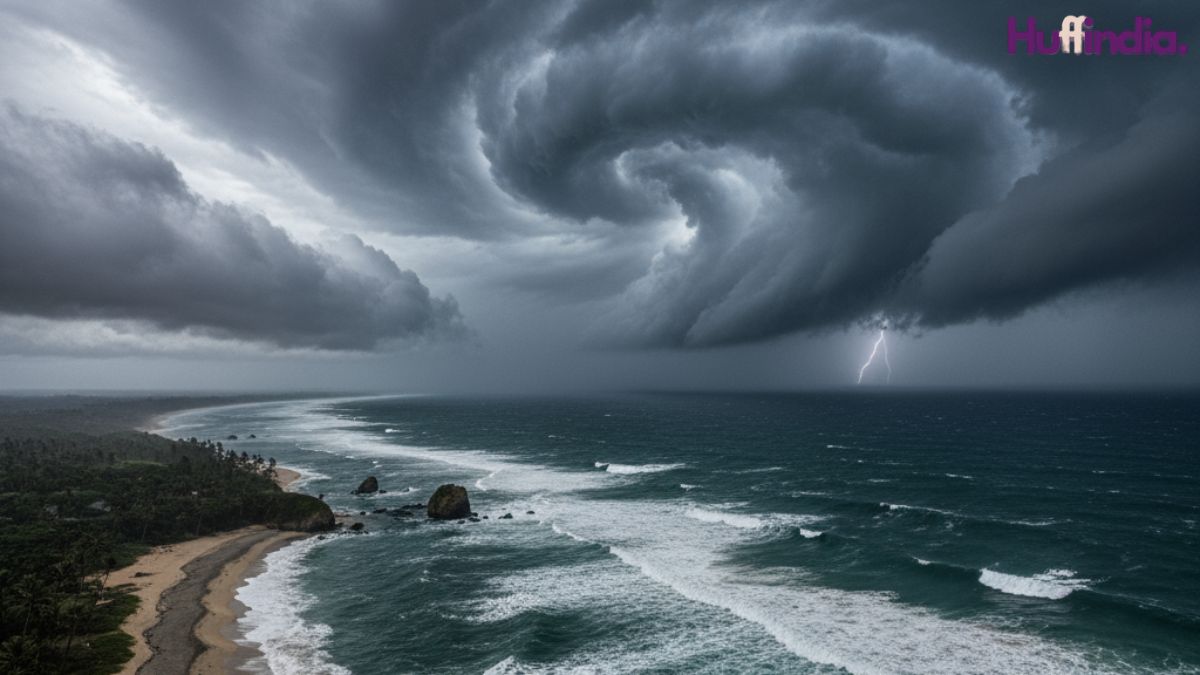The India Meteorological Department (IMD) has issued a severe weather alert as Cyclone Montha approaches the Andhra Pradesh coast, with landfall expected near Kakinada during the late evening hours of October 28, 2025. The cyclonic storm, which intensified rapidly over the Southeast Bay of Bengal, poses significant threats to coastal communities with predictions of extremely heavy rainfall, strong wind speeds exceeding 120 kilometers per hour, and dangerous storm surge conditions.
Authorities in Andhra Pradesh and Odisha have taken precautionary measures, including the closure of schools until October 30 and evacuation orders for vulnerable coastal areas. The state government has activated disaster management protocols and positioned rescue teams across affected regions to respond swiftly to any emergencies. Meteorological officials have classified Cyclone Montha as a “severe cyclonic storm”, indicating dangerous conditions that demand immediate public preparedness and adherence to official warnings.
The weather system originated from a deep depression that formed over the Bay of Bengal approximately one week ago. Continuous monitoring by the IMD revealed rapid intensification driven by warm ocean temperatures exceeding 29 degrees Celsius and favourable atmospheric conditions. Satellite imagery shows a well-organised cloud structure with a pronounced center, characteristic of strengthening cyclonic systems. The storm is moving in a westerly direction toward the Indian coast at an approximate speed of 18 kilometers per hour.
Anticipated Impact and Rainfall Predictions
Meteorological authorities predict extremely heavy rainfall of 150-200 millimeters in isolated areas of coastal Andhra Pradesh districts including Nellore, Tirupati, Chittoor, and Kadapa. Some locations may experience even higher precipitation as the cyclone makes landfall. Additionally, moderate to heavy rainfall is expected across neighbouring regions of Odisha including Srikakulam and Ganjam districts. Fishermen have been advised to immediately return to shore, with warnings issued not to venture into the Bay of Bengal until conditions normalize.
The storm surge prediction indicates an increase of 0.5 to 1.0 meter above the astronomical tidal level in coastal areas. This poses flooding risks in low-lying regions, potentially breaching embankments and inundating agricultural fields and residential areas near the coast. Wind speeds are expected to peak near 120-130 kilometers per hour during the most intense phase, capable of causing significant structural damage to buildings, uprooting trees, and disrupting power supply infrastructure.
Government Response and Evacuation Measures
The Andhra Pradesh State Disaster Management Authority has mobilized over 500 rescue personnel across affected districts. Temporary shelters have been established in safer locations away from coastal zones, with arrangements for essential supplies including food, drinking water, and medical assistance. District administration officials report that approximately 15,000 residents have been voluntarily or mandatorily evacuated from high-risk areas to designated relief camps equipped with basic amenities.
Chief Minister Y.S. Jagan Mohan Reddy directed officials to ensure zero casualties through effective preparedness. The state administration coordinated with the National Disaster Response Force (NDRF) to position additional personnel in vulnerable locations. Communication networks have been tested, and backup systems established to maintain connectivity during the storm. Pre-positioned emergency supplies, including generators, fuel, food packets, and medicines, have been distributed to relief camps and control rooms.
Odisha Chief Minister Naveen Patnaik also issued directives for enhanced vigilance in coastal districts. Schools and colleges have been declared closed, and residents have been advised to remain indoors during the cyclone’s passage. The state directed fishing boats to immediately move to safe harbors and prohibited fishing operations until further notice.
Agricultural and Infrastructure Concerns
Agricultural experts express concern about potential crop damage to standing crops in the affected districts, particularly rice and vegetables currently under cultivation. The heavy rainfall combined with strong winds could cause substantial losses to the farming community. State agricultural departments have advised farmers to secure loose materials and take measures to protect their crops to the extent possible. Insurance claims processes have been expedited, and compensation mechanisms are being readied for affected farmers.
Power infrastructure officials have started removing weak tree branches near overhead power lines and secured transformers against potential damage. The electricity distribution companies announced probable power outages in coastal areas and assured rapid restoration services once conditions permit. Water supply authorities have filled overhead tanks to ensure adequate reserves during the outage period.
Fisheries Sector Alert
The cyclone warning poses significant challenges for the fishing industry. Approximately 8,000 fishing vessels operate in the Bay of Bengal, and authorities have instructed all boats to immediately return to harbors. Fishing harbors in Visakhapatnam, Kakinada, and other ports are experiencing increased boat traffic as fishermen rush to seek shelter. Port authorities have arranged for adequate mooring facilities and security arrangements. The fishing season impact could stretch to several weeks, affecting the livelihoods of thousands of fishing families.
Public Advisories and Safety Guidelines
The IMD has issued comprehensive public advisories recommending residents to:
- Avoid unnecessary travel during the cyclone period
- Secure loose outdoor objects including flowerpots, outdoor furniture, and signboards
- Trim weak branches overhanging buildings
- Stock essential supplies, medications, and drinking water
- Keep emergency contact numbers accessible
- Follow all official directives and warnings issued by district administration
- Remain indoors, preferably in interior rooms away from windows
Health authorities have been alerted to ensure readiness for emergency medical response. Hospitals have been asked to maintain adequate stock of essential medicines and ensure full operational capacity of emergency wards. Mobile medical units have been positioned to support relief camps.
Historical Context and Preparedness
Cyclone Montha follows the pattern of other cyclonic systems affecting the Bay of Bengal region. Historical data indicates that October experiences seasonal cyclonic activity in the Indian Ocean, with the coastlines of Andhra Pradesh and Odisha particularly vulnerable. The rapid intensification witnessed in this system aligns with climate scientists’ observations regarding intensifying weather patterns due to changing ocean temperatures.
The Indian government has invested significantly in cyclone warning systems and disaster management infrastructure. The advanced radar network and satellite monitoring capabilities have enabled accurate predictions and timely public alerts. Community awareness programmes conducted regularly have enhanced public understanding of cyclone preparedness.
Conclusion
Cyclone Montha represents a critical weather event requiring public cooperation and adherence to official guidelines. While meteorological technology has enabled accurate forecasting, public safety ultimately depends on individual responsibility and community cooperation. Residents are urged to treat the cyclone warning with utmost seriousness and follow all directives issued by authorities. Post-cyclone damage assessment teams have been kept ready to evaluate losses and guide recovery efforts. The state government emphasises that collective vigilance and preparedness will minimise potential casualties and property damage.
Stay tuned for more articles Huffindia.com
























